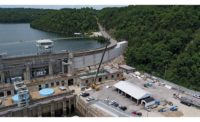The Midwest construction industry set new records for revenue in 2019, according to respondents to ENR Midwest’s Top Contractors survey. Eighty-eight firms from each of the region’s 11 states reported a total of $42.5 billion in 2019 revenue, up from the previous record of $38.8 billion in 2018.
Once again, firms tackled a wide array of projects, from hotels in Minnesota to distilleries in Kentucky, art museums in Iowa and roadwork in Ohio.
Chicago-based Clayco moved into the top spot after finishing second on last year’s list, reporting $3.25 billion in regional revenue for calendar year 2019. That’s a jump from the $2.68 billion the company reported in 2018, and it made Clayco the only company on the list to break the $3-billion mark. Nearly all respondents, including nine of the top 10, reported revenue based on the calendar year.
Clayco CEO Bob Clark attributes the firm’s success to a number of large-scale local projects such as the 460,000-sq-ft reconstruction of the Willis Tower that Clayco is working on in a joint venture with the No. 2 ranked firm on this year’s list, Turner Construction, which reported $2.99 billion in 2019 revenue. Clayco’s other clients include Amazon, Pfizer and the University of Illinois.
Last year Clark told ENR Midwest design-build was the most rapidly growing delivery method in the market. Does he still view it that way a year later?
“Oh yeah, more than ever,” Clark says. “We’ll see even more post COVID. The real estate brokerage community has grown more comfortable with design-build, and we find ourselves marketing [it] more directly to corporations.”
|
Related Link |
Clayco also leads the list of design-builders with $2.94 billion of its total revenue coming from the delivery method.
Minneapolis-based Mortenson came in third with regional revenue of $1.64 billion. The remaining top five firms included Chicago’s Walsh Group Ltd. (with $1.58 billion in revenue) and Kansas City’s JE Dunn Construction (with $1.51 billion).
The size of the firms responding to the survey ranged from those with more than 5,400 regional employees (No. 12, Omaha-based Kiewit Corp.) to a handful of boutique firms with less than 10 regional employees. The average number of regional employees across all respondent firms was 584.
While Clayco focused on design-build, 78th-ranked J.T. Magen from Chicago went nearly all-in on telecommunications, deriving 93% of its 2019 revenue from that sector. The firm’s largest project to break ground for the year was the $45 million The Study at The University of Chicago. But it was another local project that proved even more daunting.
In early June 2020, Magen completed its work on the 196,000-sq-ft data center for CoreSite Realty. The building was designed to hold the massive weight-bearing needs of large data center equipment, with a design load of 24 mw with redundant utility and cooling systems. But what sets it apart is the location—1432 South Clinton St. in Chicago’s South Loop business district. Traditionally, data centers are built in the suburbs or even in rural areas due to site logistics and power needs, not in a crowded downtown area.
“Data centers are in the background, until they aren’t,” says Geoff Arend, executive vice president of J.T. Magen. “You look at where we are now (in mid-2020) and everyone is suddenly reliant on Zoom meetings and Netflix.”
Magen had to juggle myriad problems that come with the threading-a-needle issue of downtown construction. The firm had to coordinate scheduling delivery of equipment to minimize traffic disruption, coordinate relocating overhead utility lines and dance around deliveries at a 24-hour United Parcel Service distribution facility across the street. Additionally, buildings in downtown Chicago need extensive foundations because of the soft soil. J.T. Magen’s solution was to drill 219 caissons, each averaging 55 ft deep. The drilling alone took two months.
“Every data center is different, so you’re navigating them on the fly,” Arend says. “There are lots of ‘what-if’ conversations. Lots of ‘why-can’t-I-do-that?’ Some of it is just crazy. Like, we ended up spending $100,000 on shipping equipment here just because of the timing involved.”
Of course, the world is considerably different in mid-2020 than it was when many of the firms on the list closed their calendar-year books. The COVID-19 pandemic has touched nearly all industries worldwide, and construction is no different. The question remains how the industry will be going forward.
“Are there challenges? Yes,” says Justin Brown, CEO of 28th-ranked Skender with $420.5 million in regional revenue. “But there are silver linings as well. It’s still a banner year for revenue, and it’s a great time to strengthen relationships with customers. The key thing is to not necessarily react to the chatter of the last couple months, but to ask, ‘How can we be better partners?’”
Brown acknowledges that the challenges brought forth by the pandemic are something no one’s ever seen. But he and others within the industry say it is built to face such challenges.
“It really led to an understanding of how connected the world is on supply chain,” Arend says. He pointed to a specific example in which Magen worked with a steel manufacturer in Idaho for a project in Silicon Valley, but was delayed due to the detailer in India being shut down over coronavirus precautions. “You see how small the construction world is and our world in general. It’s sort of empowering to fight through that.”







Post a comment to this article
Report Abusive Comment